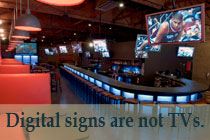Five Things Businesses Should Know About Digital Signage
1. Digital signage is Not TV
Digital signage is taking a myriad of forms today, but don’t confuse it with television. Television is strictly news and entertainment. Television is seen in the bars with a dozen screens hung in every corner and alcove in the facility. There is n
o real strategy behind it, because there is no real control of it.
DS which masquerades as TV to the casual observer is different. Digital signage may show Rachel Ray whipping up a quick dish. It mig

ht display weather, news, stock quotes or daily specials. Regardless of what is playing on the screen, the hardware, software and underpinnings of digital signage are not the same as TV. The content has a purpose. There is a business strategy behind it. That is the primary difference. If you install digital signage, you ought to have a purpose.
Digital signs are commercial, flat screen monitors intended for heavy use and managed content. Digital signage is a business investment that includes clearly defined objectives and provides measurable results. And while television-like content may be part of the strategy, it will not dominate a well thought-out business deployment. There will be underlying business drivers.
2. PowerPoint can drive a meeting, but not digital signage
Many software programs can manage content— PowerPoint is one of them. PowerPoint can create some pretty slick presentations. It delivers fancy animation, great graphics and some audio teasers. It's a terrific product for boardroom presentation, but not digital signage. Digital signage software offers much more than packaging and presentation. It is much more than PowerPoint ever dreamed of being.
Digital signage software is typically a hosted application that allows tremendous flexibility in designing multiple screen content areas, scheduling content play time remotely and managing it daily. It allows real time updates to hundreds of screens at one time. It can play video files, display high resolution image files and push out RSS feeds simultaneously on one screen. Digital signage software is a new sophisticated breed not to be mistaken for presentation software.
3. Digital signage should be incorporated as part of your marketing plan
Most businesses don’t quite understand how to use digital signage... yet. Digital signage is relatively new, and fresh concepts are being explored all the time. How you use digital signage will vary depending on your business.
Some businesses, such as quick service restaurants, will benefit from having digital menu boards installed in their restaurant and managing pricing and product promotions for multiple locations in minutes, rather than hours. Other businesses will benefit by purchasing an ad spot on a specialty network to launch a new product. You can find bar, hotel, retail, liquor and many other specialty networks today that support this.
And still others decide they want to build and drive their own network, where they carry their own messages and sometimes push third party advertisers to generate revenues. Some hotel are capitalizing on this model.
Regardless of whether it is used for branding, product lift, revenue generation or event promotions, digital signage should be part of your annual marketing spend because businesses and consumers are starting to watch those screens more than the ones in their homes.
4. Content is king
No different than the Web, digital signage is all about quality and relevancy. The better the content, the more eyeballs are going to follow it. But quality implies more than just eye candy. Quality content presumes there is a honed, relevant message behind it that is polished and shined. Don’t skimp on design. And keep it fresh. Old content is dead content. And no one looks at anything dead very long. Keep your content and/or network alive and thriving with fresh, relevant content!
5. There is more to marketing than ROI
More than ROI? Blasphemy! The mere hint of that could have you tarred and feathered not too long ago. But today businesses realize an ROI-only marketing plan is too short-sighted to build a leading brand. Return on investment is one way of measuring success, but you really ought to think bigger. Today ROO (return on objective) can be just as important to an integrated marketing plan.
It can sometimes be difficult to measure ROI for a digital signage advertising campaign without a response mechanism. But a campaign launched with a well-defined objective can be very productive and measureable using digital signage. For example many businesses are running short code campaigns via digital signage. Since dynamic screens are ten times more likely to be viewed than static images, the results are exponentially better than similar static promotions. Now companies are building their text databases at a far greater rate for future mobile marketing campaigns. ROI will be easier to calculate on the future campaigns, but digital signage can achieve many well thought-out objectives.
By Stephen Germino, Director of Marketing & Business Development at SIGNUM Digital Solutions. SIGNUM Digital Solutions is the leading provider of digital signage solutions in the Greater Boston area. SIGNUM is a full-service digital signage company that offers expertise within the seven elements of digital signage. SIGNUM serves the hospitality, retail, education, banking and restaurant markets, providing custom solutions for each digital signage deployment.
 Stephen Germino
Stephen Germino
Reader Comments